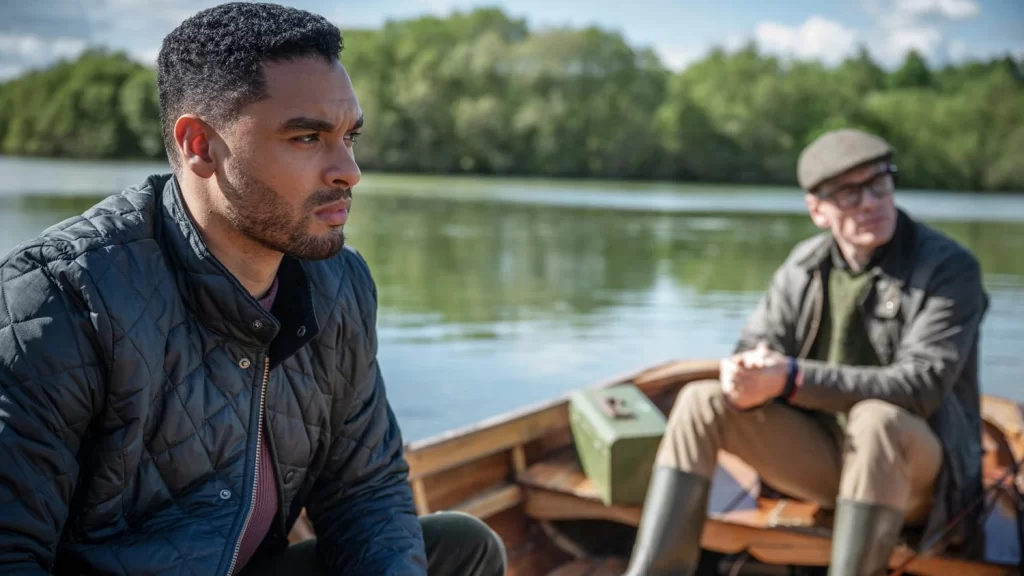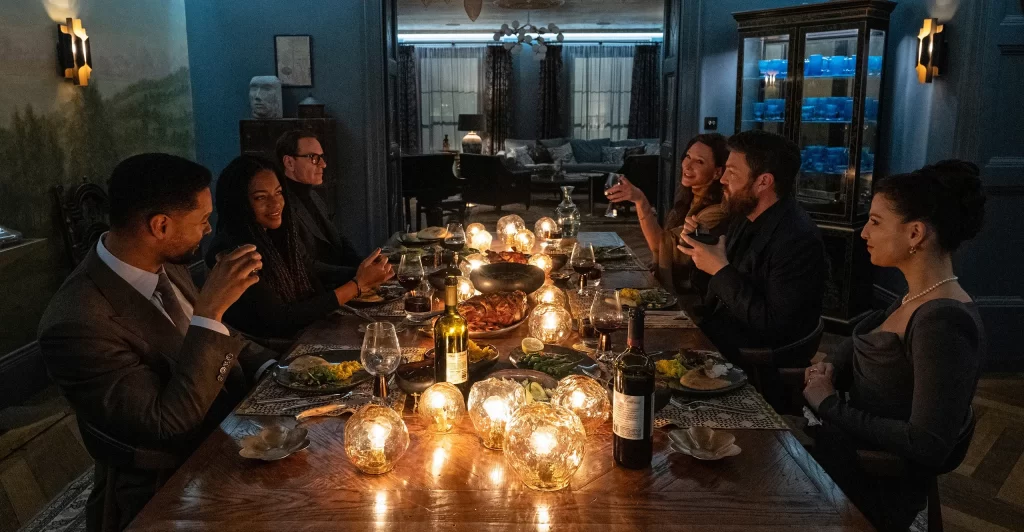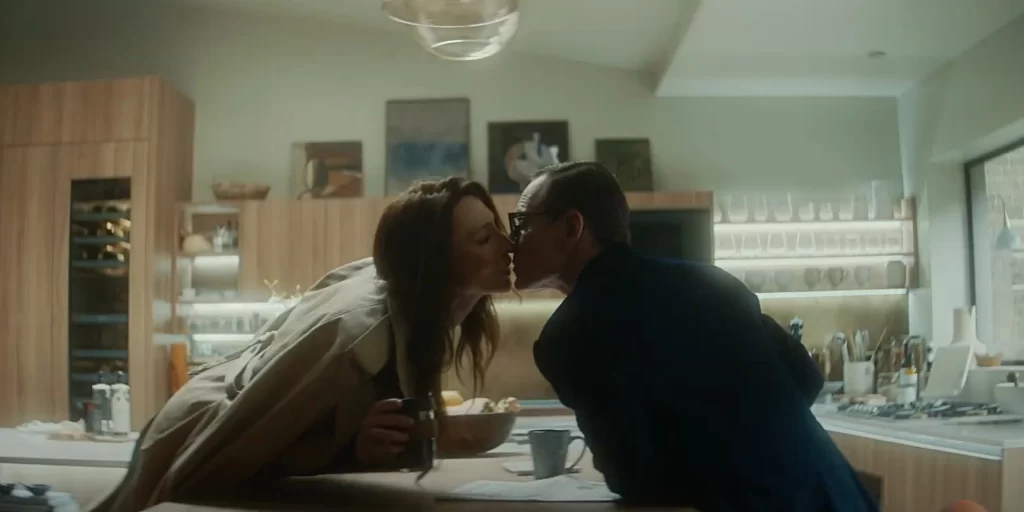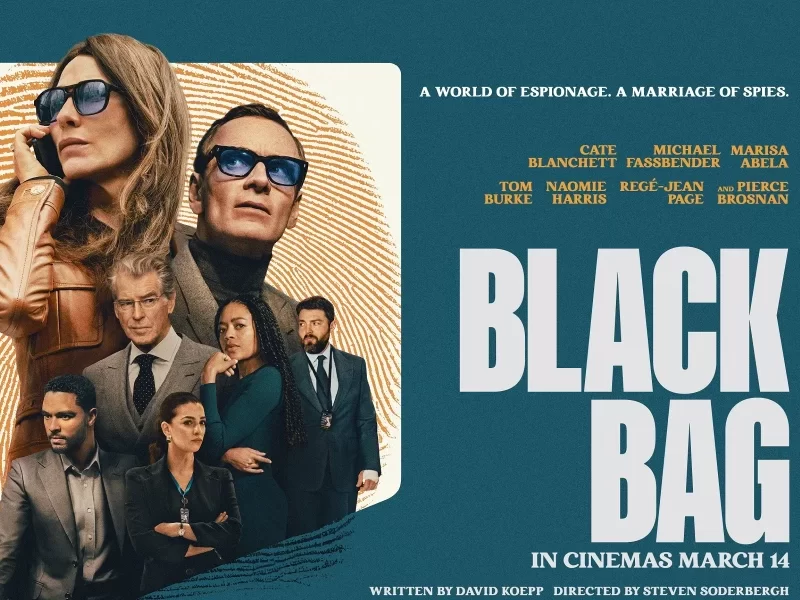Black Bag is Steven Soderbergh’s second release this year following up Presence which came out in January. While Presence is my favourite movie of the year to date – review here – I set out to see if Soderbergh could top himself to unseat his previous release. Black Bag is a sleek spy thriller with a strong cast that follows Michael Fassbender’s character unraveling a leak in his spy agency with his wife played by Cate Blanchett as the main suspect.
Point 1: Sleek Chic Mystique

Although I don’t want this to become a Steven Soderbergh glazing piece – okay it will be. But I’ll keep it to a minimum! That said… Boy does my boy Steve know how to make a movie look good. Hollywood at this point has perfected the look of that sterile spy headquarters offices feel, and Soderbergh follows in those footsteps. However, Fassbender’s George and Blanchett’s Kathryn’s house in this movie is absolutely gorgeous and the shot selection and the lighting used throughout is just sublime.
And if we’re going to talk about lighting, the first big dinner scene is to die for. The candles on the table lighting everyone’s faces as the tension tightens and the emotions flow was just incredible. I was awestruck by how beautiful that whole scene looked and anyone with an appreciation for great lighting will not forget this scene anytime soon.
The places look great, but the people look even better. Everyone is dressed perfectly, whether they are in sleepwear or in a suit. You could take a screenshot of almost any scene and you’d think wow this looks great. And yet, somehow all that is achieved in a relatively small scale movie with scenes almost exclusively taking place in a house, an office, and a lake.
Point 2: Talk the Talk, Walk the Walk

The poster child for the snappy back and forth dialogue is Aaron Sorkin. But I wouldn’t put Soderbergh far behind if you look at his Ocean’s trilogy. However, credit where credit is due: this film is actually written by David Koepp, who also wrote Presence. And Koepp does his own version of Sorkin’s signature style. It’s less frenetic, but more frantic. I know that sounds like I just garbled two words, but let me explain.
Sorkin’s work is frenetic. It’s the tight back and forth of the deposition scenes in the Social Network. It’s the ebb and flow in dialogue between Brad Pitt and Jonah Hill in Moneyball. There’s energy and speed, but it’s almost too choreographed. Koepp takes that style and mixes it with strong emotions to make something that feels messier, but just as effective with a more organic rising tempo.
Once again, the dinner scene in the first act is the perfect example of this. By making George someone who only speaks when necessary, Koepp marries his negative space to the nonstop banter of the rest of the characters to create this dynamic that you can see happening without the need for description. As the scene goes on, the energy builds and builds and crescendos in a release that feels earned and cathartic. Yet all the while, there was no plot happening. It was the perfect vehicle for exposition without having done any exposition at all.
Koepp and Soderbergh manage to capture the perfect “show, don’t tell” example of how to nail exposition. And if that weren’t enough, they also drop my favourite line of dialogue of 2025 so far with no fanfare in the middle of the relentless pingpong of banter when Clarissa played by Marisa Abela tells Tom Burke’s Freddie to “shut the fuck up when you talk to people.” Still can’t get over how hilarious that line is.
Point 3: Surgical Precision

If you’re going to make a quintessential espionage film (and I strongly believe this is one) and have it run only 90 minutes, there is no other way to do it but to nail every aspect with surgical precision. But you also can’t have this feel like a speedrun where you don’t take the right amount of time to establish everything before it’s resolved. That’s quite the tightrope act and Soderbergh and Koepp manage to show off by walking on their hands from beginning to end.
You could make this movie run 2 and a half hours and I don’t think it would feel long. There is enough material, style and story here that you could have absolutely let it breathe. In fact, my first thought coming out of the movie is actually how a story like this is easily something that Hollywood would have wanted to drip feed and make it into a season of a show akin to Slow Horses or Mr. & Mrs. Smith (more on that later). Again, I don’t feel like that would have been inappropriate either.
In fact, to me, that’s what feels so impressive about compressing this into 90 minutes and still feeling like nothing was missing. Of course, the obvious place you need that precision in is editing, but you can’t just edit any movie down to 90 minutes and make it work. No, the art of this efficiency lies in the small moments between George and Kathryn that are allowed to breathe so you can experience their dynamic as a couple.
It is exemplified in the choice to take the moment to show George splashing the smallest drop of curry on his white dress shirt’s cuff and then having him go change even though no one would have noticed. It makes you realize how if you commit to the mantra of “show, don’t tell,” you actually save a lot of time. My other favourite such moment is when Pierce Brosnan’s character is angry about something and rather than spell it out or have an emotional outburst, all you see is his left eye starting to twitch in anger and it tells you everything you need to know.
Those are just a couple of examples of these moments, but the film is full of them and to me, that’s why the total package of the film works.
Point 4: Mr. & Mrs. Smith Who?

A story revolving around a spy couple is hard to not compare to Mr. & Mrs. Smith. That movie or show, whichever is your preferred medium, sets the bar for these types of stories. That’s not to say these stories haven’t come before or since, but that is the go to comparison for people.
Now I don’t think this smaller, more niche film without the star power or blockbuster energy of Brad Pitt and Angelina Jolie’s 2005 flick is going to unseat that IP. But I do think the energy that Blanchett and Fassbender bring is magnetic and thrives on espionage rather than action. The Mr. & Mrs. Smith film is much more an action film than a spy one. The show leans much more into spycraft, but action is still a very prevalent aspect.
Black Bag steeps its identity in research, logic and ruses. George is painstakingly meticulous in his ability to plot and see what is happening. Kathryn’s ambitious and sexy aura fills every scene with an unmissable presence. Together, I think they form the most formidable spy couple I’ve seen on the silver screen. The theme of dysfunctional relationships permeates the film from beginning to end, but somehow throughout, George and Kathryn exemplify that there is function to be found within dysfunction. The excellent performances by the lead actors are of course part and parcel of what makes this relationship work on screen. Can’t get much better casting for these roles.
Overall, Black Bag is everything cinema should be. I think this will be just as enjoyable whether you watch it on a plane, at home or in the theatre. The shots are beautiful, the dialogue is inch-perfect and the performances are great. I cannot recommend this movie enough.
If you’re looking for more spy stuff, why don’t you check out my reviews of Slow Horses – Series 1, Series 2 and 3, and Series 4 – or see if the Mr. & Mrs. Smith show might be up your alley with my review for that here.



